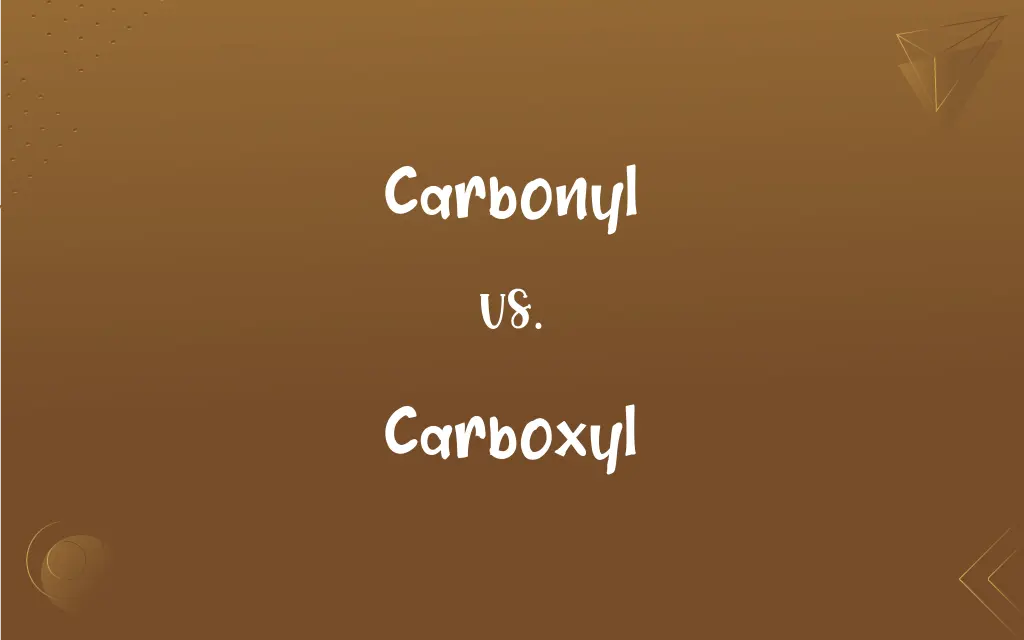Carbonyl vs. Carboxyl: What's the Difference?
Edited by Aimie Carlson || By Harlon Moss || Updated on October 21, 2023
Carbonyl is a functional group with a carbon-oxygen double bond (C=O); carboxyl has a carbonyl and hydroxyl group (COOH).

Key Differences
The carbonyl group is a characteristic feature of many organic compounds. It consists of a carbon atom double-bonded to an oxygen atom, denoted as C=O. This functional group can be found in various types of molecules, including aldehydes and ketones. On the other hand, the carboxyl group is a specific type of carbonyl that's bonded to a hydroxyl group, symbolized as COOH. This makes it an essential component in organic acids.
Carbonyl compounds can be broadly categorized based on the position of the carbonyl group and the types of atoms bonded to the carbonyl carbon. For example, if the carbonyl carbon is bonded to a hydrogen and an alkyl group, it's an aldehyde. However, the presence of the carboxyl group immediately classifies a compound as a carboxylic acid, which is a subset of organic acids known for their acidic properties.
In terms of reactivity, carbonyl compounds are typically reactive due to the polarity of the C=O bond. Electrophiles and nucleophiles can attack this bond, leading to a variety of chemical reactions. Conversely, the carboxyl group imparts acidity to carboxylic acids. This is because the hydrogen atom in the hydroxyl portion can be easily donated as a proton, making these compounds acidic.
From a structural perspective, while both carbonyl and carboxyl groups contain a carbon-oxygen double bond, their behaviors in organic reactions differ considerably. The carbonyl group, being a simpler entity, engages in addition and oxidation reactions, among others. In contrast, the carboxyl group, due to its acidic nature, often undergoes reactions that involve the exchange of its proton, such as esterification.
To summarize, while the carbonyl group is a foundational entity found in a diverse range of organic molecules, the carboxyl group is a specialized version of a carbonyl, intrinsically linked to the acidic properties of carboxylic acids. The presence or absence of the hydroxyl group in conjunction with the carbonyl defines their differences.
ADVERTISEMENT
Comparison Chart
Structural Formula
C=O
COOH
Compound Types
Aldehydes, Ketones, etc.
Carboxylic Acids
Presence of Hydroxyl Group
Absent
Present
Typical Reactivity
Addition, Oxidation
Esterification, Acid-base reactions
Example
Acetone (a ketone)
Acetic acid (a carboxylic acid)
ADVERTISEMENT
Carbonyl and Carboxyl Definitions
Carbonyl
An entity found in various organic compounds like aldehydes and ketones.
The carbonyl in butanone gives it its distinctive properties.
Carboxyl
A functional group found in carboxylic acids comprising a carbonyl and hydroxyl.
The carboxyl group in benzoic acid imparts its acidic nature.
Carbonyl
A functional group characterized by a carbon-oxygen double bond.
Formaldehyde contains a carbonyl group, making it an aldehyde.
Carboxyl
An entity participating in reactions like esterification.
The carboxyl group in formic acid can react with alcohols to form esters.
Carbonyl
A polar group due to the differing electronegativities of carbon and oxygen.
The carbonyl's polarity makes it reactive towards nucleophiles.
Carboxyl
A combination of carbonyl and hydroxyl functional groups.
The carboxyl in citric acid plays a crucial role in the citric acid cycle.
Carbonyl
A descriptor for compounds containing the C=O bond.
Carbonyl chlorides are used in the synthesis of certain polymers.
Carboxyl
A distinguishing feature making organic compounds acidic.
The carboxyl in propanoic acid can donate a proton.
Carbonyl
A central feature in many organic reactions.
The carbonyl in benzaldehyde is the site of nucleophilic attack.
Carboxyl
A site of reactivity in various organic transformations.
The carboxyl in acetic acid can be reduced to form ethanol.
Carbonyl
The bivalent group C=O.
Carboxyl
The univalent group, -COOH, the functional group characteristic of all organic acids.
Carboxyl
(organic chemistry) A univalent functional group consisting of a carbonyl and a hydroxyl functional group (-CO.OH); characteristic of carboxylic acids.
Carboxyl
The complex radical, CO.OH, regarded as the essential and characteristic constituent which all oxygen acids of carbon (as formic, acetic, benzoic acids, etc.) have in common; - called also oxatyl.
Carboxyl
The univalent radical -COOH; present in and characteristic of organic acids
Carboxyl
Relating to or containing the carboxyl group or carboxyl radical
FAQs
Can carbonyl compounds be polar?
Yes, due to the C=O bond's polarity.
In which compounds is the carbonyl group typically found?
Aldehydes, ketones, and many other organic compounds.
What is the primary structural feature of a carbonyl?
A carbon-oxygen double bond (C=O).
What's a simple test for carbonyl compounds?
The 2,4-dinitrophenylhydrazine (Brady's test) can detect carbonyl compounds.
What happens when a carboxylic acid reacts with a strong base?
It forms a carboxylate salt.
Are carboxyl groups found in amino acids?
Yes, amino acids have both amino and carboxyl functional groups.
How does the carboxyl group influence molecular polarity?
It increases polarity due to the electronegativity of both oxygen atoms.
Why are carboxylic acids considered acidic?
The carboxyl group can donate a proton.
Can carboxylic acids form salts?
Yes, by donating a proton to a base.
What's the significance of the carboxyl group in acids?
It imparts the acidic properties to carboxylic acids.
What's a common reaction involving carbonyl compounds?
Addition reactions, especially with nucleophiles.
How do carboxylic acids typically react with alcohols?
Through esterification, producing esters.
Are all compounds with a C=O bond considered carbonyl compounds?
Generally, yes, but context matters; carboxylic acids also have a C=O bond but are defined by the COOH group.
Are carbonyls present in sugars?
Yes, sugars can have aldehyde or ketone carbonyls, classifying them as aldoses or ketoses.
How can one differentiate between aldehydes and ketones?
Both have carbonyls, but aldehydes have a hydrogen atom bonded to the carbonyl carbon, while ketones do not.
How does a carboxyl group differ from a carbonyl?
It has an additional hydroxyl group (COOH).
Do carbonyl compounds participate in oxidation reactions?
Yes, especially aldehydes, which can be easily oxidized.
Can carbonyl compounds form hydrogen bonds?
The carbonyl oxygen can accept hydrogen bonds, but the group itself cannot donate them.
Are carboxylic acids soluble in water?
Many are, especially lower-molecular-weight acids, due to the ability of the carboxyl group to form hydrogen bonds with water.
Can carboxylic acids be reduced?
Yes, typically to alcohols.
About Author
Written by
Harlon MossHarlon is a seasoned quality moderator and accomplished content writer for Difference Wiki. An alumnus of the prestigious University of California, he earned his degree in Computer Science. Leveraging his academic background, Harlon brings a meticulous and informed perspective to his work, ensuring content accuracy and excellence.
Edited by
Aimie CarlsonAimie Carlson, holding a master's degree in English literature, is a fervent English language enthusiast. She lends her writing talents to Difference Wiki, a prominent website that specializes in comparisons, offering readers insightful analyses that both captivate and inform.































































